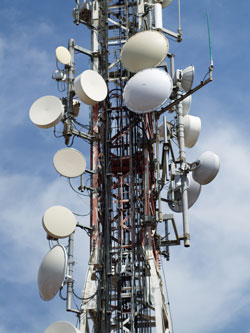By: John Shepler
The United States is extensively wired, except in remote areas like farms, rural homes, businesses outside city limits, new developments, and some industrial parks. While universal service often provides phone access, broadband internet is less certain. This is where Wireless Internet Service Providers (WISPs) come in.
WISPs function like cell phone providers but focus on high-speed internet. Unlike 4G cellular data, which has low usage limits, WISPs offer generous data allowances similar to cable, telco, or fiber optic services. Traditional providers struggle to connect less populated areas cost-effectively due to the expense of laying cables underground or on poles. WISPs eliminate this cost by using wireless signals. Users typically need a small dish antenna and receiver to capture the signal from a WISP tower.
Where Do WISPs Get Their Broadband?
Although WISPs distribute broadband like WiFi, their signal must originate somewhere. In the early days of the internet, T1 lines effectively served WISPs and cell towers in remote areas. T1 lines use standard telephone wiring and can transmit data over long distances. However, they have a limited bandwidth of 1.5 Mbps per line. Faster speeds require multiple lines, increasing costs proportionally, and capping speeds at around 10-12 Mbps.
Higher Speed Copper Lines
Ethernet over Copper (EoC) is a newer technology using existing copper telephone lines. It offers higher speeds, reaching 20-30 Mbps or more, although transmission distance is limited. EoC is increasingly available in outlying areas and provides a more cost-effective option than T1 for moderate speeds.
Business cable broadband can deliver hundreds of Mbps but is often limited to metropolitan areas. However, it has become more common in outlying subdivisions and business parks. If available and permitted by the cable company, this option can be a very affordable way to provide internet to a WISP.
Fiber Optic Service
Fiber optic lines are the current gold standard for bandwidth. Once rare, competition has made them more prevalent, even in rural areas. The expansion of 4G cellular networks, which also use fiber optic cables, has made this possible. Ethernet over Fiber (EoF) services have become very affordable and provide reliable, scalable bandwidth from 10 Gbps up to 100 Gbps.
Microwave Transmission
Using wireless technology to provide internet to a WISP is a viable solution gaining popularity as telecommunications companies transition to 5G. Microwave transmission is a point-to-point wireless service where a small dish antenna on the WISP tower receives a signal from the service provider, essentially acting as fiber without the physical cable.
SDN Combines Bandwidth
Software Defined Network (SDN), also known as SD-WAN, offers a solution for exceeding bandwidth limitations of individual providers. This technology combines various connections like T1, EoC, cable broadband, microwave, fiber optic, and even satellite internet to create a faster, more robust feed for the WISP tower. The SDN controller optimizes data traffic for each packet to ensure maximum performance.
If you’re developing or operating a WISP, explore available bandwidths and pricing for your target area. Consultants can help you navigate the options.


